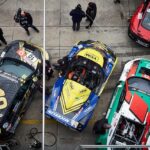As the roar of engines and the thrill of high-speed competition captivate millions of motorsport fans worldwide,three premier racing series—INDYCAR,Formula 1 (F1),and NASCAR—stand at the forefront of the sport. While each offers a unique blend of engineering prowess,strategic gameplay,and adrenaline-pumping action,their core philosophies,race formats,and technical regulations significantly set them apart. In this article, we delve into the big differences that define these racing giants, exploring the nuances of their vehicles, the intricacies of race strategies, and the cultural identities that have emerged around them.Whether you’re a die-hard fan or a curious newcomer, understanding the distinctions between INDYCAR, F1, and NASCAR sheds light on what makes each series so compelling in the world of motorsports.
INDYCAR and F1: Contrasting Engineering and Aerodynamics in Open-Wheel Racing
While both INDYCAR and Formula 1 represent the pinnacle of open-wheel racing, their engineering philosophies and aerodynamic designs diverge significantly. In INDYCAR,teams often prioritize cost-efficient aerodynamic packages due to the series’ focus on competitive balance and parity among teams. These packages are designed to ensure that the car is adaptable to a variety of ovals, street circuits, and road courses, emphasizing versatility. Engine performance in INDYCAR is also tightly regulated, which leads to closer racing and strategic pit stops that keep the competition fierce.Additionally,teams rely on a standard chassis,which minimizes the engineering gaps between competitors,promoting excitement and unpredictability throughout the season.
In stark contrast, Formula 1 is marked by its relentless pursuit of innovation and cutting-edge technology. F1 teams invest heavily in research and development, leading to highly bespoke aerodynamic solutions tailored for specific tracks. This differentiation is highlighted in their use of intricate elements, such as active aerodynamics, adjustable front and rear wings, and complex floor designs that create downforce and reduce drag effectively.The freedom in technical regulations allows teams to explore unique concepts, such as Ferrari’s concept of exploiting boundary layer management or Mercedes’ innovative front suspension designs. The relentless engineering race in F1 not only creates performance disparities but also showcases the sport as a battleground for the world’s foremost automotive engineers.
The NASCAR Experience: A Closer Look at Stock Car Racing Dynamics and Fan Engagement
The NASCAR experience is unique compared to other motorsport leagues, heavily influenced by the dynamics of stock car racing and its passionate fan engagement. Unlike the precision engineering that characterizes Formula 1 and the open-wheel design of INDYCAR, NASCAR relies on heavily modified, powerful vehicles built from stock cars. This design leads to thrilling racing scenarios on oval tracks, where the physicality of racing is palpable. Key aspects of the NASCAR experience include:
- Close Racing: The design promotes competitive racing, allowing for bumper-to-bumper action and frequent, dramatic lead changes.
- Fan Interaction: Fans enjoy unprecedented access to drivers and teams, including opportunities for meet-and-greets and pit tours.
- Cultural Engagement: NASCAR embraces local traditions and embraces diverse communities, making each race a celebration.
NASCAR’s unique engagement strategies also play a crucial role in attracting fans. Events like “NASCAR Race for Diversity” and community initiatives help the organization connect with a broader audience. In addition, the incorporation of advanced technology such as live telemetry and social media updates enhances the spectator experience. Below is a comparative analysis of engagement strategies across three major racing leagues:
| Feature | NASCAR | INDYCAR | F1 |
|---|---|---|---|
| Fan Access | High; includes pit access and meet-and-greet events | Moderate; limited pit access during races | Low; strict regulations limit access |
| Race Format | Oval tracks with lap-based racing | Road and street courses with varied layouts | Road and street courses with emphasis on time trials |
| Community events | Extensive community outreach and diversity programs | Some local outreach initiatives | Global fan events, but less community-focused |
Comparing Race Formats: How INDYCAR, F1, and NASCAR Differ in Strategy and Spectacle
In the realm of motorsport, INDYCAR, F1, and NASCAR stand out with their distinctive race formats, each demanding a unique strategic approach from teams and drivers. INDYCAR is known for its ovals and road courses, emphasizing versatility and adaptability. The races often feature strategy-focused elements such as tyre management and fuel efficiency, where pit stop timing can make or break a race. With high-speed ovals like the famed Indianapolis 500, the spectacle comes from both the intense competition and the thrilling atmosphere created by fans.Conversely,Formula 1 boasts a more technical edge,showcasing cutting-edge technology and precision. The emphasis on aerodynamics, hybrid power units, and intricate tire strategies requires teams to analyze every aspect of their cars and the circuit, crafted by unique tracks around the globe, from Monaco’s winding streets to the speed of Suzuka.
NASCAR, on the other hand, revolves around stock car racing predominantly on oval tracks, steeped in tradition and its own brand of excitement. The racing format tends to be a bit more straightforward, with longer race durations that can lead to dramatic fender-to-fender battles and last-lap heroics. Fuel strategy is critical, often leading to varying pit strategies that can change the race’s outcome in an instant.Moreover, the spectacle of NASCAR is amplified by its close-knit fan culture and the electric atmosphere at race tracks, creating a community-focused experience.In comparing these three giants of racing, it’s evident that each format offers a compelling blend of strategy and performance, appealing to diverse audiences worldwide.
| Aspect | INDYCAR | F1 | NASCAR |
|---|---|---|---|
| Race Types | Ovals, Road Courses | Road Courses, Street Circuits | Ovals |
| Strategy Focus | Tire Management, Fuel Efficiency | Aerodynamics, Technology | Pit Strategy, Fuel Management |
| Fan Experience | Intense Competition, Atmosphere | Technical Precision, Global Appeal | Community-Centric, Close Racing |
In Summary
As we conclude our exploration of the significant differences between INDYCAR, Formula 1, and NASCAR, it’s clear that each motorsport series offers a unique blend of culture, technology, and competition. INDYCAR captivates fans with its open-wheel racing and oval challenges,showcasing the versatile skill set of its drivers. Formula 1, with its global presence and cutting-edge technology, continues to push the boundaries of performance and strategy, drawing audiences into a world of innovation and luxury. Meanwhile, NASCAR remains steadfast in its American roots, emphasizing tradition, community, and a distinct brand of stock car racing that resonates deeply with fans.
Understanding these differences not only enriches our appreciation for each series but also highlights the diverse tapestry of motorsport as a whole. Whether you’re cheering on your favorite driver at an oval track,tuning in for the precision of a street circuit,or reveling in the thrilling atmosphere of a road course,each discipline contributes to the vibrant world of racing. As the seasons progress and rivalries intensify, fans can look forward to exhilarating battles that embody the spirit of competition in all its forms.










